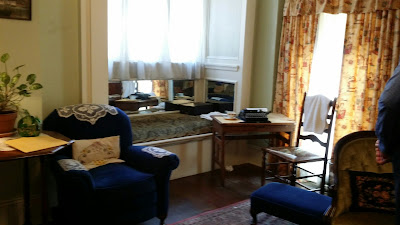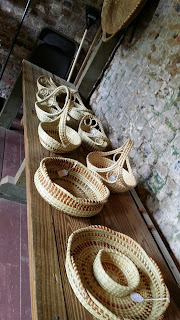Saturday
Finally in a new state, Georgia.
Headed to Helen, a little town that was recommended as a must see since it looks "just like a European village".
Driving thru the beautiful back country roads to Helen, I came across the
Old Sautee Store which has been open and doing business continuously since 1872.
In that time it has been owned by only three families.
It had for sale everything a general store should. I bought cheese.
The little faux Swiss village of Helen, GA turned out to be a disappointment.
It did look a little like a Swiss village if you've never been to Switzerland.
The town fathers remade its image in the 1960s to attract tourists who were coming to Northeastern Georgia for the mountains and lakes.
A bigger disappointment was the Civil War Reenactment I had come to see was actually last weekend. The tourist info I had was a misprint. Darn.
On to Atlanta. As I approach the modern skyline I remind myself there won't be much of the Old South here since General Sherman burned most of it in his march to the sea in 1864.
Thank goodness Margaret Mitchell's home still stands, even if it is in the midst of downtown office buildings now.
She wrote Gone With The Wind in one of the apartments of this home in 1935.
This is the rear of the home where Margaret and her husband lived as newlyweds in the bottom left apartment for several years.
She had been a reporter for the local newspaper and when she broke her ankle, began writing GWTW, her first complete novel.
For inspiration she drew on all the stories about the Civil Was she had heard as a child growing up every time her family got together. It wasn't until she reached adulthood that she found out the Civil Was was not a recent event. Her family referred to it as tho it happened yesterday.
The tiny living room of the two room apartment was where she worked on the classic.
After their wedding the reception was held here for 60 people. The guests must have been sitting on each other's laps.
There was no dining room so the couple ate in the bedroom next to the tiny kitchen.
Her husband was an editor with the newspaper where she had been employed.
The building also contains a museum telling of the making of the movie
and its premier in Atlanta in 1940, the biggest event in Atlanta before or since.
Martin Luther King's father was a pastor here and organized a choir to perform at the premier. Martin Luther King Jr as a child can be seen in one of the old photos in the front row of the choir.
Many local African Americans were not pleased with the stereotype of their race in the movie.
Friend and neighbor from the Villages, Jim, flew in to ride along with me this week.
We travel married style; I drive and he holds the map and we fight about it. Just to be clear, he gets a motel room and I sleep in the Doodle. This would be a friendship trip, no romance. I only had to remind Jim a few times.
We saw the Stone Mountain Monument to the Confederate heroes:
President Jefferson Davis, Generals Robert E. Lee and Stonewall Jackson.
The carving surface of the monument is one and one half acres
and is so large a man could fit in the mouth of one of the horses.
Our first night we had pizza for dinner and the waitress said the motel we had reserved was known for prostitutes. We should have told her we were from California and didn't have very high standards. It was late so we stayed anyway and it was fine. I slept well in the Doodle in the parking lot and Jim only had someone knock on his door in the middle of the night once.
Driving south we stopped for lunch at Greenville in a local cafe.
The waitress asked "kin ah hep yew?" Love the local accents. We are starting to "Yes, Ma'am and Yes Sir" each other. Someone said "Cheat yet?" I thought
no this is not a romantic trip. He was saying "Did you eat yet?"
In Warm Springs we toured the FDR museum and the Little White House where he died in 1945. The only thing missing in the museum was any mention of Lucy Mercer.
The warm mineral springs where FDR came to get relief from polio have been drained and not used since the 60s.
He did a great deal for the people of the town with electricity and other progressive help.
On to the beautiful old city of Savannah. Founded in 1733, it was laid out in a grid pattern with 22 squares in the 2 and 1/2 mile historic district, the largest in the country.
This fountain at Forsythe Park was ordered from a catalog and assembled on the spot in 1858.
Most Southerners have few kind words for General Sherman but will grudgingly admit he showed some class when he spared the city of Savannah and presented it to Abraham Lincoln as a Christmas present effectively ending the Civil War, or the "Recent Unpleasantness" as some of the more genteel Southern ladies refer to it.
After the trolley ride to orient ourselves we got off and found ourselves wandering for hours thru the brick paths and trickling fountains in the parks that are surrounded with 200 year old homes so close to the city center.
This is the Mercer home on Monterey Square, the site of the real life murder in the best seller and movie "Midnight in the Garden of Good and Evil".
In all of Savannah there are more than 1,000 historic homes, most still lived in as homes. Many of the homeowners give their addresses not by street numbers, but by the genealogy of ownership, the Barrow House or the Juliet Gordon Low House, the founder of the Girl Scouts.
In the Ships of the Sea Marine Museum on River Street we found a spectacular collection of scale model replicas of sailing ships and a collection of scrimshaw and other nautical items. Jim got lots of ideas for the ship model he is building.
You can't be in Savannah without enjoying the Southern hospitality of Mrs. Wilkes Dining Room.
At our communal table we visited with folks from Michigan and Florida while passing around plates of 23 different dishes of every Southern food ever created, all of it amazing and some of it not even fried.
We were smitten with Savannah but pressed on South toward the barrier islands of the Low Country.
On St. Simon Island we wandered out to the pier and watched crabs being caught, took a tour and had lunch. Another Shrimp and Grits dish for me. I'm addicted.
On Jekyll Island we visited the Georgia Sea Turtle Center and watched a procedure to attach a weight pouch to this turtle. They all had names. Joan had sustained an injury which caused her to swim almost perpendicular so a weight was being attached to the top rear of her shell to allow her to swim horizontally. Now the other turtles won't make fun of her.
The Indigo Coastal Shanty is a little joint on Brunswick Island where we went for dessert after dinner.
I heard from a woman at the Turtle Center that the Georgia Peach Pound Cake here was absolutely orgasmic. The pound cake is griddled in butter, topped with a giant scoop of vanilla bean ice cream, with bourbon caramel sauce and pecans. It would probably kill me but I was willing to take the chance. It took 3 days to finish.
Heading South to St. Augustine we toured the old fort of Castillo San Marcos of 1672, where we watched the canons being fired and heard of the siege where 1200 townspeople and 300 soldiers were camped out for 3 months holding off the British.
We met another celebrity.
Almost didn't recognize Kramer out of NYC.
Did some people watching while waiting for our
tour trolley.
And of course the obligatory visit to the Fountain of Youth, a tourist trap too irresistible to pass up.
If this doesn't work, there's always the $20K face lift.
This beautiful old city is smaller than we had imagined, even the historic area was quite compact.
It's known for a lot of firsts:
the first Catholic parish the Cathedral of St Augustine from 1565
the first wax museum, etc
It is also known apparently for at least one last,
there is a Howard Johnson's here which is practically extinct.
Took Jim to the airport and I'm off to see the rest of Florida. It was good having him along this week.
I do get tired of the sound of my own voice.























































